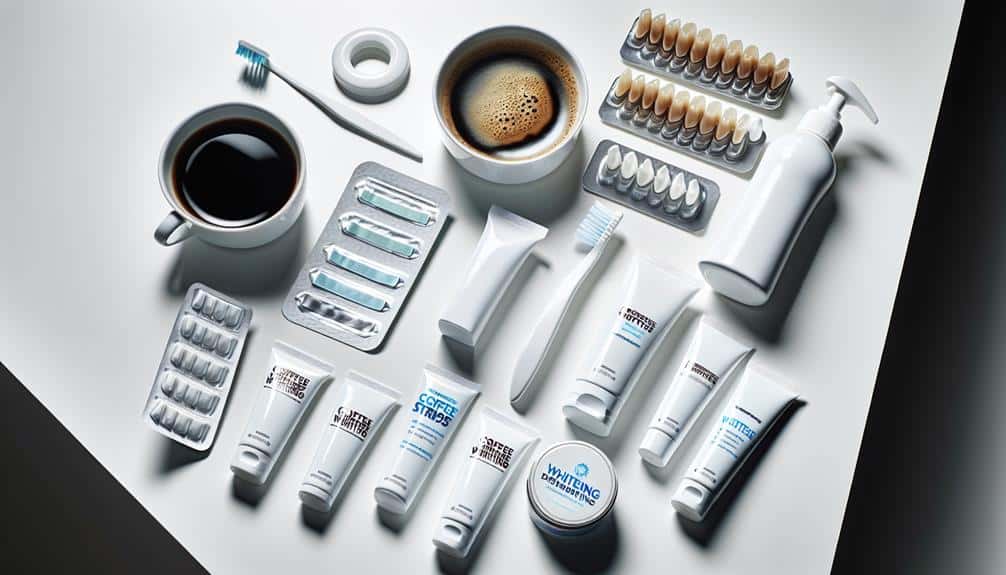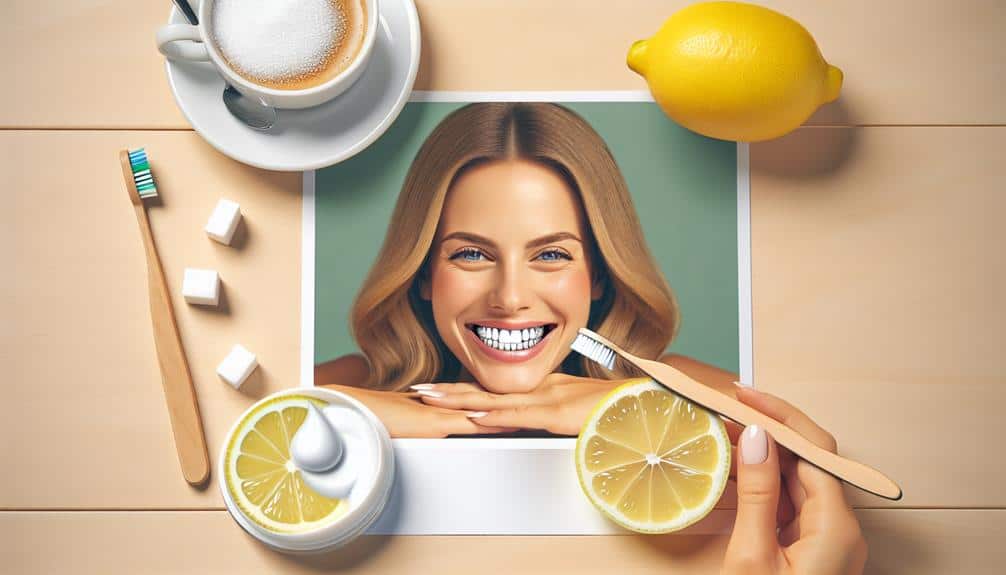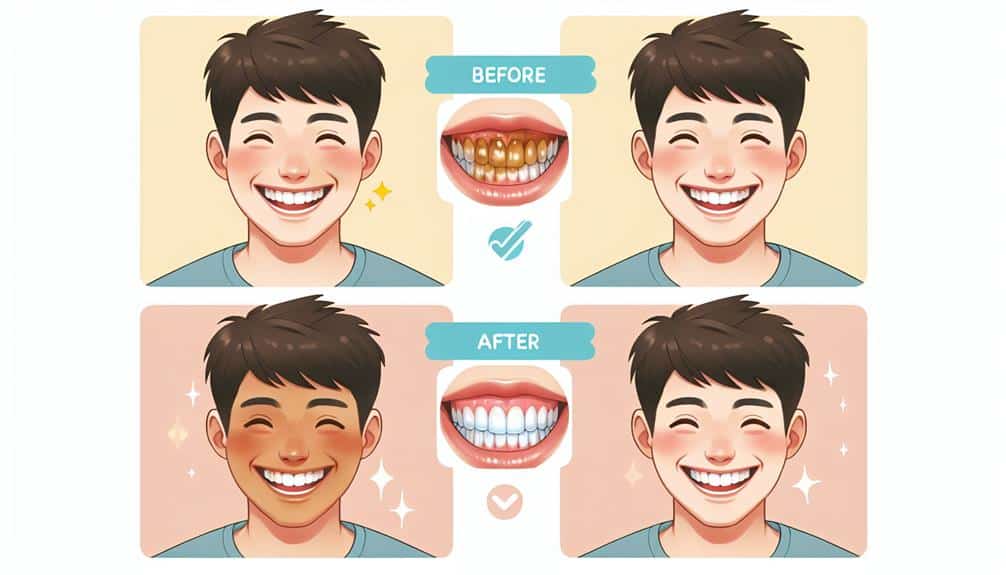If you want to tackle coffee stains on your teeth, consider over-the-counter solutions. Whitening strips with hydrogen peroxide gently bleach discoloration. Whitening toothpaste contains abrasives to remove surface stains but may not match professional treatments. Whitening pens offer precision application with hydrogen peroxide or carbamide peroxide for mild to moderate stains. Whitening mouthwashes break down stains, prevent new ones, and freshen breath. Whitening kits come with gel and trays for at-home brightening. Try DIY remedies cautiously after consulting with a dentist. These products provide efficient ways to achieve a brighter smile.
Key Points
- Whitening strips with safe bleaching agents for controlled whitening.
- Whitening toothpaste removes surface stains but not a substitute for professional treatment.
- Whitening pens for quick results and on-the-go touch-ups.
- Whitening mouthwash breaks down stains and prevents new ones.
- Whitening kits with effective ingredients for convenient at-home use.
Whitening Strips for Coffee Stains
When seeking to tackle coffee stains on your teeth effectively, consider incorporating whitening strips into your oral care routine. Whitening strips are a popular over-the-counter option for addressing dental discoloration. These strips typically contain a bleaching agent, such as hydrogen peroxide or carbamide peroxide, which helps to lighten the stains on your teeth.
Compared to home remedies or DIY treatments, whitening strips are formulated with specific concentrations of whitening agents that are safe for dental use. They provide a convenient and controlled way to whiten your teeth without causing damage to your enamel when used as directed.
To use whitening strips, simply apply them to your teeth according to the instructions on the package. Most products recommend leaving the strips on for a specific amount of time each day over a course of several days to achieve the best results. Incorporating whitening strips into your oral care routine can be an effective way to combat coffee stains and brighten your smile.
Whitening Toothpaste for Stained Teeth
To address coffee stains on your teeth, consider incorporating whitening toothpaste into your daily oral care routine. Whitening toothpaste contains abrasives and chemicals that help remove surface stains caused by coffee and other pigmented foods. While these toothpastes can be effective in mildly reducing stains, they may not provide the same level of whitening as professional treatments or dental cleanings.
It's important to manage your expectations when using whitening toothpaste for stained teeth. These products work best for maintaining the whiteness of your teeth after a professional treatment or between dental cleanings. They aren't a substitute for professional whitening procedures, which can offer more dramatic results.
Whitening Pens for Coffee-Stained Enamel
For effective treatment of coffee-stained enamel, consider utilizing whitening pens as a convenient solution. Whitening pens are designed with pen applicators that allow for precise application of the whitening gel directly onto the teeth. These pens are a popular choice for individuals looking to target specific areas of discoloration with ease. The whitening gel in these pens typically contains hydrogen peroxide or carbamide peroxide, which are effective whitening agents commonly used by dentists.
One of the key advantages of whitening pens is their quick results. The convenience of these pens allows you to apply the whitening gel directly onto the enamel, making them a handy option for on-the-go touch-ups. However, it's crucial to follow the instructions provided with the product to ensure safe and effective use.
While whitening pens can produce noticeable results, they may not be as effective on severe stains or provide the thorough whitening achieved through professional treatments. Nevertheless, for mild to moderate coffee stains, whitening pens can be a practical and efficient solution.
Whitening Mouthwash for Discolored Teeth
Consider incorporating whitening mouthwash into your daily oral care routine to address discolored teeth effectively. Whitening mouthwashes are formulated to help remove surface stains and prevent further discoloration. Here are three key benefits of using whitening mouthwash:
- Mouthwash Effectiveness: Whitening mouthwashes contain active ingredients such as hydrogen peroxide or carbamide peroxide, which help break down stains on the teeth's surface, leading to a brighter smile over time.
- Discoloration Prevention: By using whitening mouthwash regularly, you can help prevent new stains from settling on your teeth. This proactive approach can be especially beneficial for individuals who regularly consume staining beverages like coffee or tea.
- Fresh Breath: Many whitening mouthwashes also come with mint or other fresh flavors that leave your mouth feeling clean and your breath fresh, enhancing your overall oral care routine.
Incorporating a whitening mouthwash into your daily regimen can complement your efforts to maintain a brighter, healthier smile while promoting good oral hygiene habits.
Whitening Kits for Coffee-Stained Smiles
Incorporating whitening kits specially designed for coffee-stained smiles can be a critical and effective solution to enhance the brightness of your teeth. These kits typically include whitening gel, trays, and sometimes LED lights to accelerate the whitening process. They offer a convenient way to address coffee-induced stains at home without the need for frequent visits to the dentist.
When selecting a whitening kit, it's vital to look for those with proven effectiveness and safety. Many kits contain ingredients like hydrogen peroxide or carbamide peroxide, which help break down stains and whiten teeth effectively. It's important to follow the instructions provided to avoid any potential side effects like tooth sensitivity.
While whitening kits can be a reliable option, it's also worth considering DIY remedies and natural solutions for coffee-stained teeth. These may include baking soda, activated charcoal, or coconut oil pulling, which are believed to help remove stains and promote a brighter smile. However, it's advisable to consult with a dental professional before trying any home remedies to confirm they're safe for your teeth and gums.
Frequently Asked Questions
Are There Any Potential Side Effects or Risks Associated With Using OTC Whitening Products for Coffee-Stained Teeth?
When using OTC whitening products for coffee-stained teeth, there are potential risks like gum irritation or tooth sensitivity. Follow safety precautions, read labels, and consult a dentist if needed for effective results and to minimize any adverse effects.
How Long Does It Typically Take to See Noticeable Results From Using These Whitening Products?
To see noticeable results from whitening products, follow application techniques precisely. Results vary, but expect improvement within 1-2 weeks. Address potential allergies by checking ingredients. Maintain results with proper aftercare and regular maintenance.
Can OTC Whitening Products Effectively Remove Deep-Set Coffee Stains on Teeth?
You wonder about the effectiveness of OTC whitening products in banishing stubborn coffee stains from your teeth. Natural remedies, DIY options, and professional cosmetic dentistry treatments might offer varying degrees of success. It's a journey worth exploring for a brighter smile.
Are There Any Specific Ingredients Consumers Should Look for or Avoid in OTC Whitening Products for Coffee-Stained Teeth?
When seeking OTC whitening products for coffee-stained teeth, avoid harsh ingredients like hydrogen peroxide. Look for natural alternatives such as baking soda or activated charcoal. These options can effectively whiten teeth without causing sensitivity or enamel damage.
How Often Should These Whitening Products Be Used to Maintain Results and Prevent New Coffee Stains From Forming?
To maintain results and prevent new coffee stains, use whitening products as directed. Consistent use is key; follow recommended frequency. Long-term results require a routine. Essential is crucial – establish a maintenance schedule to keep your smile bright.



